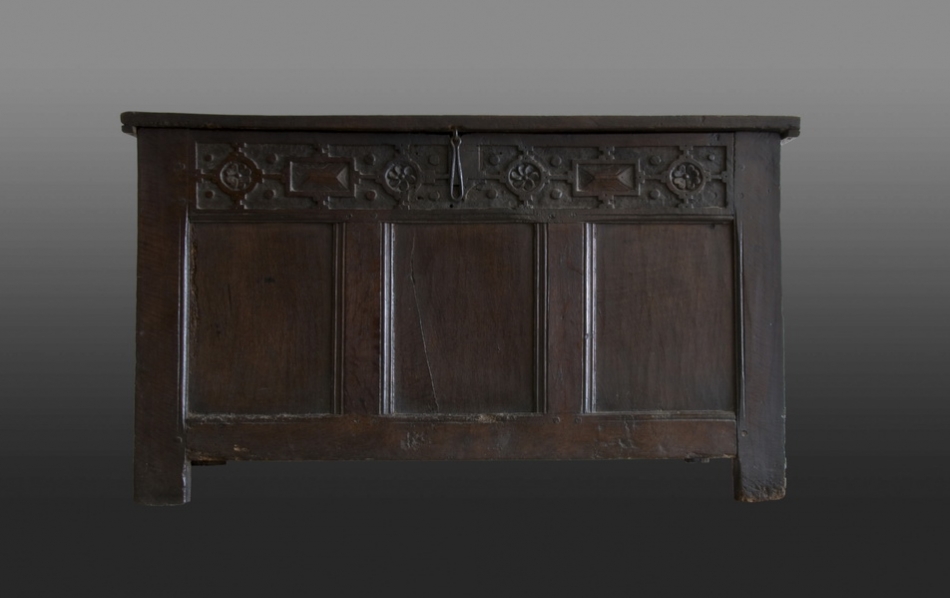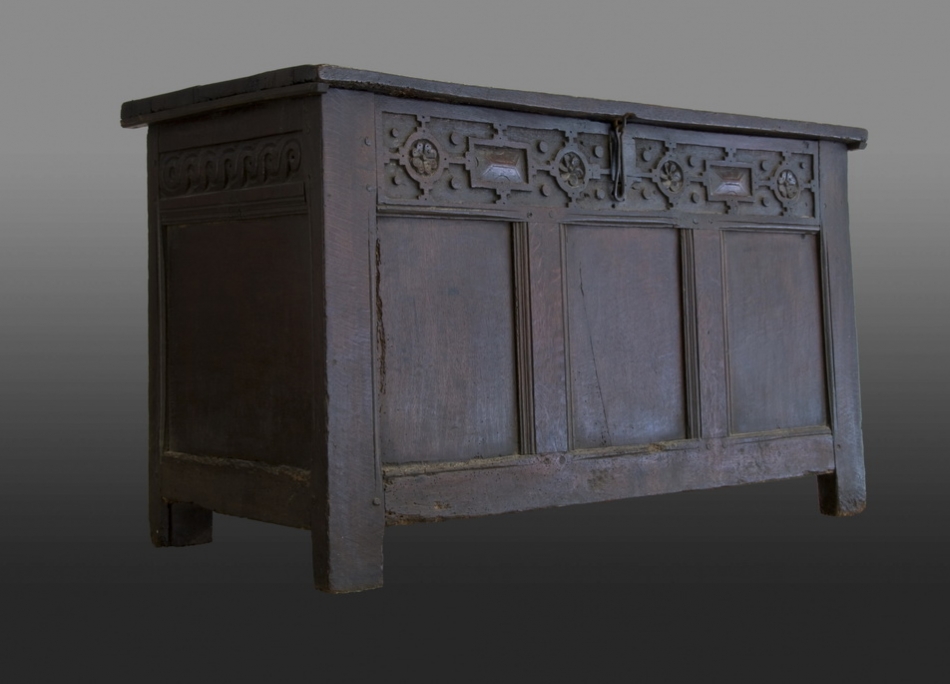Elizabeth I Exeter oak chest
Circa 1575
Exeter, Devon
W 44.5 × H 26.5 × D 19
Stock # Ex2
SOLD
This small chest is among the earliest examples of movable furniture associated with the immigrant Netherlandish workshops established in Exeter during the third quarter of the sixteenth century. No other example has come to light so closely paralleling the earliest high-level fixed woodwork in the Low Countries-derived Exeter-manner, which owes so much to the ornament prints of Van Vredeman de Vries. The chest is the work of the same joiners shop responsible for a large surviving suite of extravagantly ornamented paneling recovered from a house in the centre of Exeter in 1856 (Victoria & Albert Museum). The design of the V&A Exeter paneling features Continental strap-work and cartouches, classicised architectural compositions, interlaces, and motifs such as lion masks and humanoid grotesques. Several of the upper horizontal panels are carved with compositions based directly upon elements of de Vries' designs published between 1560 and 1564 in [Architectura] Das Erst Buch. Such direct references to an Antwerp pattern book combined with the overall sophistication of the carving militate towards the conclusion that the artisans responsible were immigrants and closer to the cultural origins of this tradition of workmanship. With only minor variations, the formalised strap-work carved on the top front rail of the chest replicates the pattern which appears on the floor rails of the V&A paneling. This distinctive formulation also derived from a de Vries design consists of a running band of pyramidal lozenges alternating with fan-like rosettes and quartered flower-heads, all contained within a defined border; small, rounded satellite motifs appear on either side between each major element. There are further congruencies between the V&A paneling and this deceptively plain chest. The muntins of the chest are of identical proportion and are run with the same mouldings as those of the woodwork. The facade of the chest, in fact, is an abbreviated and inverted version of the floor rail and first layer of plain panels from the woodwork. Like the woodwork, the chest is composed of the highest quality slow-grown, clear grained oak timber. Its deep rust colour betrays local origin and indicates
the chest was likely constructed before Exeter reached its wood-starved condition in the late sixteenth century. Use of massive bottom rails (nearly double the width of the top rails) in the chests framing is consistent with architectural practice and reflects authorship by joiners more accustomed to constructing fixed woodwork than moveable furniture. Juxtaposed with the V&A Exeter paneling, the chest provides important evidence that even the most elite of Exeter joiners workshops were sometimes contracted to produce relatively inexpensive and simple movable furniture.
A less complex version of the formalised strap-work carved on the top front rail of this chest and the floor rails of the V&A Exeter paneling appears on the front bottom rails of a chest attributed to Thomas Dennis in the collection of the Metropolitan Museum of Art. The persistence of this motif in nearly the same application with little modification over a period of nearly a century demonstrates how enduring the Low Countries-derived designs were in Exeter carving and the level to which this approach to design was entrenched in the consciousness of local artisans. No artisans responsible for the earliest Exeter joinery survived into Thomas Dennis time. Dennis, however, invariably saw their work, perhaps even the V&A paneling itself, on a regular basis.
Condition
Original lid and bottom boards. Lock recess patched; cleats and hinges replaced; Restoration to lower joint of proper-left rear stile.



